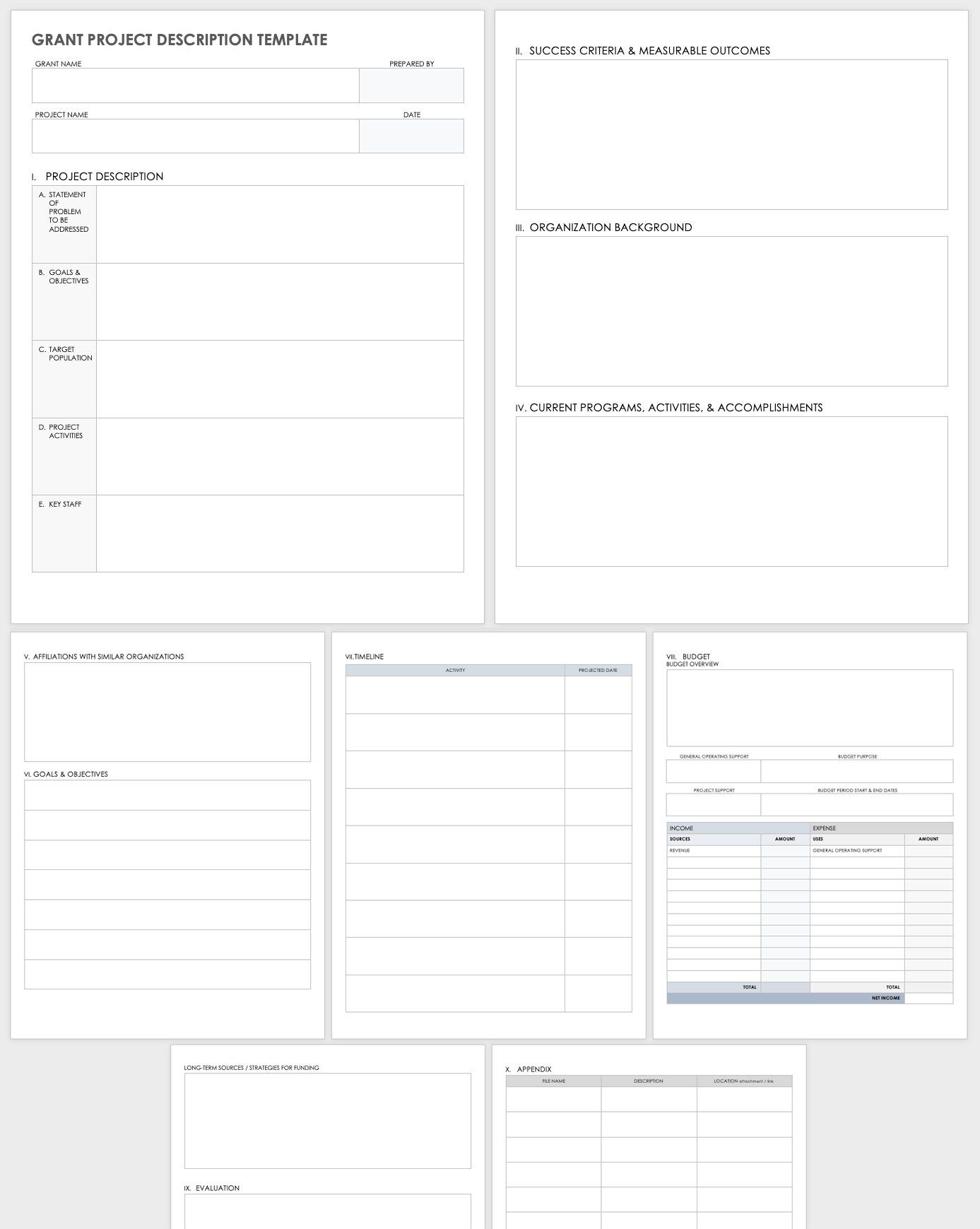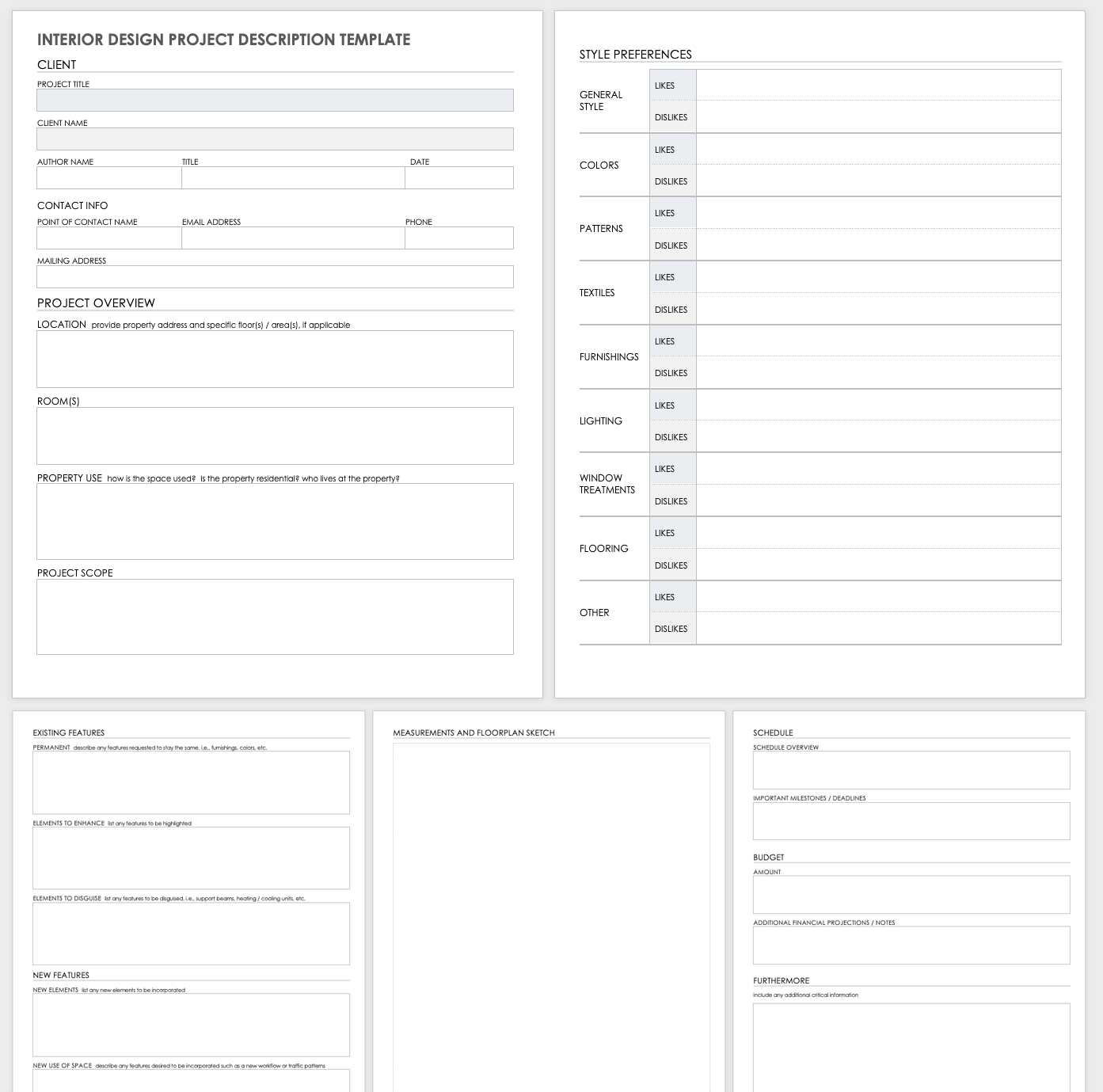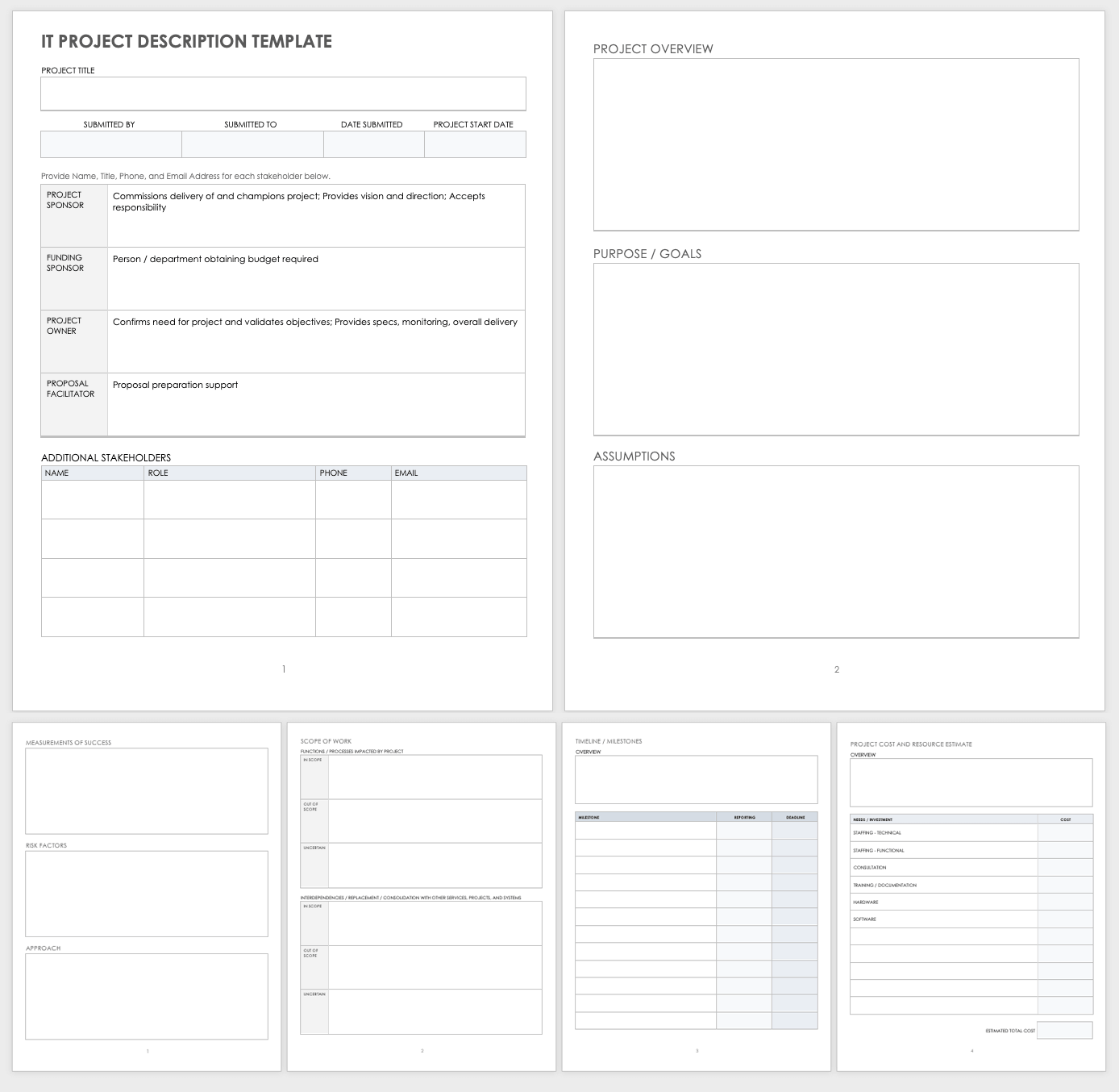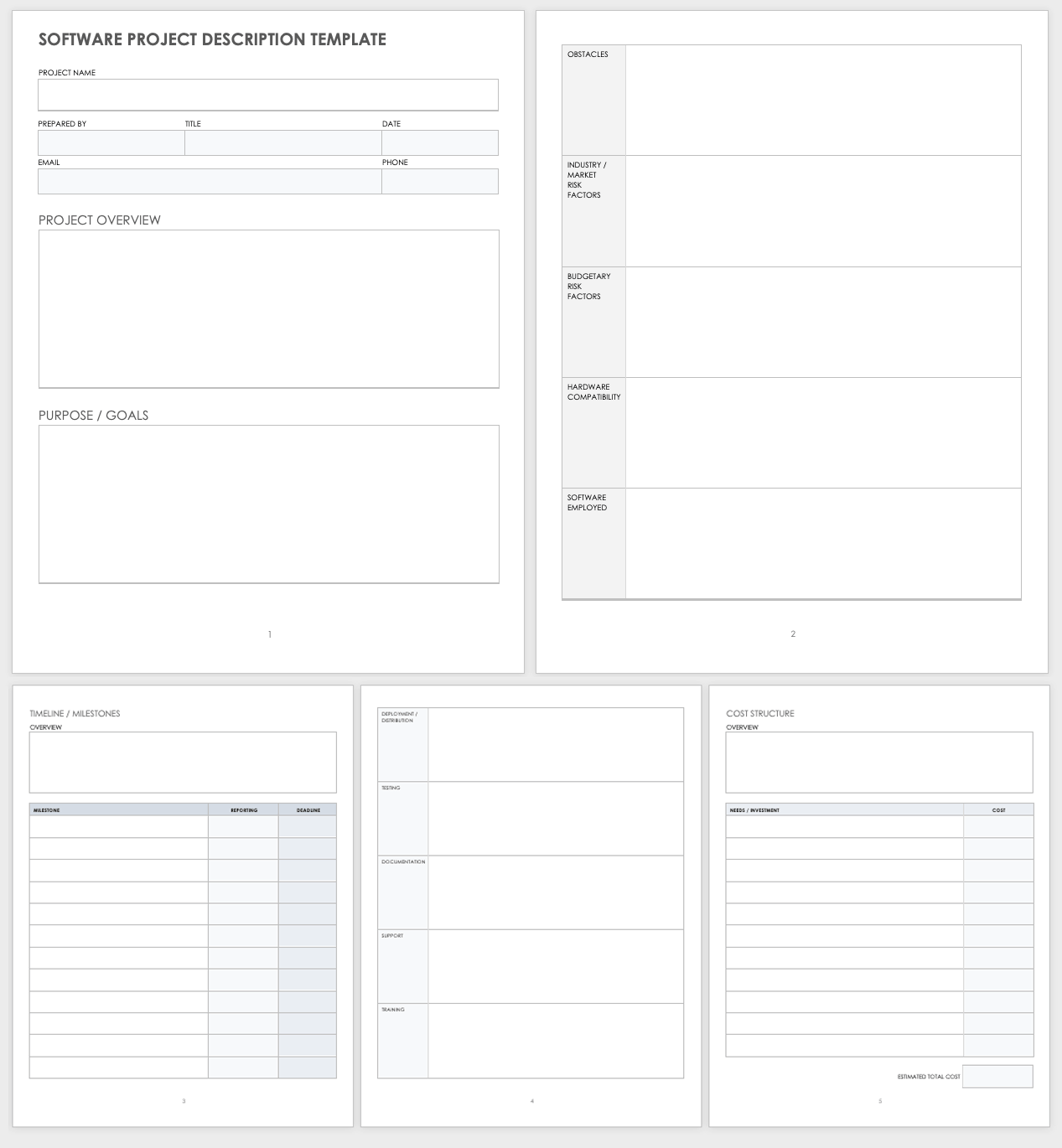What Is a Project Description?
A project description is a high-level overview of why you’re doing a project. The document explains a project’s objectives and its essential qualities. Think of it as the elevator pitch that focuses on what and why without delving into how.
You typically draft a project description early on, during the project initiation phase of the project management lifecycle.
The project manager often writes the project description. However, if you are working for an agency that seeks grant funding or writing a research proposal, you might need to learn how to write a project description in a project proposal.
The project description should include an overview of the following:
- Project goals and objectives
- Stakeholders and their roles
- Metrics for measuring success
- Timeline
- Estimated budget
The tricky part is figuring out what doesn’t belong in the project description. The description should focus on goals, objectives, and the overall approach, but you don’t need to include lists of tasks, an extensive background, or research analysis. In general, the project description is broad; you’ll include more detail in the project plan.
Project management that adapts to your needs
Work with flexibility and security—from small projects to large-scale processes and entire portfolios.
Smartsheet helps you break down projects into tasks, track progress, and manage resources, budgets, and workflows—all in one unified platform for seamless collaboration and delivery.
Project Description Outline
The parts of a project description will vary depending on the type of project. However, your project description should contain the following elements:
Parts of a Project Description Outline
- Project Title: Aim for a short, unambiguous, and memorable title.
- Overview: This is a high-level summary (no more than one or two paragraphs).
- Project Justification: Explain the problem or opportunity and why the project is necessary.
- Objectives: Set specific and measurable project goals.
- Phases of Work: Break down the project into phases that describe the desired outcome for each.
- Metrics for Evaluating and Monitoring: Include the metrics you’ll use to evaluate the project’s success.
- Timeline: Outline the timeline for each phase, including the basic tasks that you will accomplish, with start and end dates.
- Estimated Budget: Include the budget and projected costs.
How to Write a Project Description
Although writing a project description will vary somewhat depending on the type of project, the basic process is the same. The following 10 steps are key to writing a good project description.
- Summarize: Write a one- or two-paragraph explanation of what the project aims to accomplish. Avoid delving deep into background or past projects. A good project summary will not only serve as your elevator speech, but will also help you clarify larger issues with your plan.
- Define: Describe the problem or opportunity and how the project will address it.
- Set goals: Identify SMART project objectives, defined as follows:
- Specific: Answer who, what, when, where, and why.
- Measurable: Include metrics for defining success.
- Achievable: Set goals that are possible to accomplish with the available resources.
- Relevant: Goals should be aligned with your organization’s mission.
- Time-bound: Include intermediate and final deadlines for each goal.
- Explain: Briefly explain your methodology. Include any key technologies or project management techniques you’ll use and why they’re appropriate.
- Measure: Identify the project deliverables. How will you measure success and evaluate the project?
- Schedule: Include a general timeline, with project phases and milestones. Be sure to note any important deadlines.
- Budget: Include the total estimated cost of the project and how much you have budgeted. (Note that this shouldn’t be a line item budget.) Use a project budget template for a more detailed breakdown of budgeted and actual project expenses.
- Get feedback: Seek feedback from key stakeholders, customers, and anyone impacted by the project for feedback. Ask them to explain the project in their own words to get a sense of how clearly you’ve communicated the vision.
- Proofread: Have someone else proofread the project description. In addition to spelling and grammatical errors, ask them to look for missing details that are significant to the project.
- Revise: Update and revise the document as the project progresses. Treat the project description as a living document.
A 10-Step Checklist for Writing a Project Description
Now that you know how to write a project description, use this checklist to help you focus on the key details.
| A 10-Step Checklist for Writing a Project Description | |
|---|---|
| 1. | Summarize: Describe the project in a paragraph or two. |
| 2. | Define: Why is it necessary? |
| 3. | Set goals: Follow the SMART goal format. |
| 4. | Explain: Briefly explain your methodology and any key technologies or project management techniques you’ll use and why they’re appropriate |
| 5. | Measure: Identify the project deliverables. How will you measure success and evaluate the project? |
| 6. | Schedule: Include a general timeline, with project phases and milestones. |
| 7. | Budget: Include the total estimated cost of the project and your budgeted amount. |
| 8. | Get feedback: Seek feedback from key stakeholders, customers, and anyone impacted by the project for feedback. |
| 9. | Proofread: Ask someone else to look for errors and missing details. |
| 10. | Revise: Treat the description as a living document. |
Types of Project Descriptions With Examples
In this section, you’ll find a variety of free, customizable project description templates. We’ve completed them with sample information so that you can get an idea of how to write a description that fits your needs. You can also download a free project documentation template to help you track its progress.
Architectural Project Description Template
Download Architectural Project Description Template
Microsoft Word | Adobe PDF | Google Docs
An architectural project description should start with a summary that explains the need for the project. Briefly identify the site, any key design features and aesthetic considerations, and a broad timeline. Keep it simple, and write for the general public. Here’s an example of an architectural project description summary for a downtown parking garage:
After you summarize the project, use the architectural project description template to create a customizable action plan. Include a breakdown of work by phases. Note any communications and approvals needed to ensure success.
Client Creative Project Brief Template
Download Client Creative Brief Template
Create a client creative project brief to ensure a project strategy aligns with client goals. Creative briefs are frequently used for projects involving graphic design, videography, or marketing campaigns. Start by briefly describing the project, objectives, and deadlines. The following client creative project brief provides an overview of a holiday marketing campaign.
The format will vary based on the type of project. In the client creative project template example above, you’ll find a number of kickoff questions about the campaign’s target audience, key components, and messaging. If this template doesn’t meet your needs, check out other Smartsheet client creative briefs and marketing project plan templates.
Grant Project Description Template
Download Grant Project Description Template
When you’re applying for grant funding or planning a grant-funded project, it’s essential to identify the target population and how they’ll benefit from project activities. Focus on why the project is necessary, rather than on the needs of your organization. The following example describes a grant project for a program seeking funding to combat childhood hunger:
This grant project description template breaks down the description into separate sections for the problem to be addressed, goals and objectives, target population, project activities, and key staff. It provides additional space for background information, measurable outcomes, and a timeline and budget, and it includes separate columns for income sources and expenses.
Interior Design Project Description Template
Download Interior Design Project Description Template
An interior design project description is similar to a client creative project brief. You’ll use the project overview to spell out a vision for the project that syncs with the client’s needs. The following interior design project description summarizes a residential kitchen remodel project.
Use the remainder of the interior design project description template to document the client’s likes and dislikes in greater detail. The template includes space to note the client’s preferences for general style, as well as colors, patterns, textiles, furnishings, and more. You’ll also find space to include measurements, a floor sketch, a project schedule, and a budget.
IT Project Description Template
Download IT Project Description Template
Microsoft Excel | Microsoft Word | Adobe PDF
An IT project description should start with a basic summary that condenses key background information and what the project entails. Keep it simple, and explain the project in lay terms. The following IT project description summary provides an overview of a plan to develop a mobile ordering app for a fast casual restaurant:
This IT project description template includes space for goals, assumptions, measurements of success, and risks. Additionally, the template includes space for a breakdown of the scope of work, including processes impacted by the project, milestones, costs, and resources.
Software Project Description Template
Download Software Project Description Template
A software project description should start with an overview that explains the type of software that will be developed, the problem it will solve, and the benefits to users and the business. The overview shouldn’t focus on the technical aspects of the project, but instead on the final product and its benefits. This software project description example gives an overview of a point-of-sale (POS) system under development for a brewery.
Once you’ve completed the overview, use this software project description template to explain purposes and goals in greater detail. The template includes sections for obstacles, risk factors, hardware compatibility, and software employed. Other features include a detailed breakdown of the project’s timeline and cost structure.
For other project description templates, please refer to our Free Project Description Templates article.
PMP Project Description
If you’re a project manager seeking the Project Management Professional certification, you’ll need either 36 or 60 months of professional experience leading projects, depending on your education level.
The Project Management Institute (PMI) requires you to submit each project as its own entry on the application and include the following:
- A one-sentence project objective.
- Your role in accomplishing project deliverables in each of the five phases of project management: initiating (IN), planning (PL), executing (EX), monitoring and controlling (MC), and closing (CL).
- A brief description of project outcome.
You can use this PMP application project description example for guidance:
- Objective: Redesign Company XYZ’s website to improve lead generation by 25 percent.
- Project Deliverables: I was the project manager for Company XYZ’s redesign. I drafted the project charter and recruited a team of four IT staffers to complete the project (IN). I created the work breakdown structure, timeline, and budget, and I met with stakeholders to assess project contingencies and risks (PL). I coordinated between departments, provided quality assurance, and managed the four-person team throughout the project (EX). I conducted risk audits and communicated results to stakeholders (MC). I obtained stakeholder feedback, archived project documents, and held multidepartment training once the redesign was completed (CL).
- Outcome: Company XYZ’s website redesign was completed $10,000 under budget and two weeks ahead of schedule. Lead generation increased by 30 percent within six months.
How to Write a Project Description in a CV or Resume
Writing a project description for successful past projects can give you an edge when you’re a job candidate or looking for new clients. When writing a project description for your CV, resume, or portfolio, clearly state the project objective, your role, and the outcome.
Continuing with the example above, here’s a project management project description sample to avoid in your resume because it’s vague. The second project description is a more effective example. It also highlights the most significant accomplishments and responsibilities first.
Project Description Before Example
IT Project Manager, Company XYZ
Project: Website redesign
- Managed a highly successful redesign
- Provided leadership throughout the project
- Updated key stakeholders in a timely manner
- Coordinated communications and staff trainings
- Completed the project under budget and ahead of schedule, resulting in improved sales
Project Description After Example
IT Project Manager, Company XYZ
Project: Website redesign with goal of increasing lead generation by 25%
- Managed website redesign that resulted in a 30% increase in lead generation
- Completed the project $10,000 under budget and two weeks ahead of schedule
- Recruited and managed a team of four IT staffers
- Created the work breakdown structure, timeline, and budget; assessed project contingencies and risks
- Communicated with key stakeholders throughout the project; trained staff across departments once the project was complete
Tips for Writing a Good Project Description
To write an effective project description, draft early in the process. Keep it high-level without going into too much detail or background. Use the description to generate interest among a broad audience. Keep it brief and free of jargon.
- Focus on the 4 C’s: A good project description follows the 4 C’s of writing.
- Clear: Keep writing straight to the point and don’t include unnecessary jargon.
- Concise: Focus on the project itself, rather than on background information.
- Complete: This can be a challenge when you’re also aiming for concision. Regardless, the description should include the key points your audience needs to understand the project.
- Credible: Only cite authoritative sources and the most up-to-date information.
- Draft the Project Description Early in the Process: Gregory Carson, PMP, is a biomedical engineer, attorney, and patent agent with more than 20 years of project management experience and who owns Carson Patents. Carson suggests drafting the project description early, ideally as soon as the idea occurs to you or your team. The description will serve as the summary roadmap to refer back to throughout the project.
“All of the other details have some direct relationship to the project description, so having the project description well drafted before you begin the execution planning can save you time and frustration, in particular as changes need to be included,” Carson says.
At the end of the project, you’ll want to refer back to the document to show that the project fulfilled the goals and objectives. - Make a Memorable First Impression: Alan Zucker, PMP, is a project manager with more than 25 years working with Fortune 100 companies and founder of the website Project Management Essentials. He says that a project description should motivate. The goal is for people to understand and support the project after reading the description.
“When crafting your pitch, remember that most people will form their initial impressions about the project within the first 30 seconds. Lead with a strong statement and a powerful image of the project’s benefit,” Zucker says. - Write for a Broad Audience: A common mistake when writing a project description is targeting too narrow of an audience.
“There is usually no lack of attention on the stakeholders that are funding the project, and they are important audience members for the project description to focus on,” Carson says. “But particular attention focused on the stakeholders who will benefit from the project often leads to helpful insights for the project.”
Getting feedback on the description from a broader audience is also helpful. Zucker suggests reviewing the description with key stakeholders, customers, and those impacted by the project. “After reading your description, see if they can restate it in their own words,” Zucker suggests. “Was the restatement what you intended? If not, then continue to revise the description based on the feedback.” - Avoid Excessive Details, Especially Early On: Your project description should convey a vision, rather than provide a detailed implementation plan. Don’t worry too much about planning out details in the description phase — Zucker suggests that you simply make sure there’s a clear understanding of the project’s goals and why you want to proceed.
“The description will evolve as we learn more about the project,” Zucker says. “Don’t worry about committing too early. Part of that evolutionary process is sharing the description and getting feedback on it.”
Keeping a high-level focus will help generate buy-in for the project. Carson says it’s key to describe the project so that others “can understand and appreciate your marvel.”
“You don’t want to pontificate to the point where people stop reading or get confused about any of the goals and objectives,” he says. - Ask Someone to Proofread Your Project Description: Proofreading and editing are essential when you finalize your project description. But if you wrote the description, recruit someone else to edit it.
“Too often as we write, we ‘remember’ what we were writing about and can miss little details, even spelling and grammar, that can impact the meaning and importance of a project and its description,” Carson says.
Don’t be surprised if you need to revise and rewrite a few times. It’s all part of the process of crafting your message.
How to Write a Brief Description of a Project
Focus on the project and the problem it addresses. Avoid delving into background info or referencing other projects. Emphasize the what and why without excessive detail about the tasks it requires. This can be your pitch to sell the project.
What Is a Project Description in a Project Proposal?
A project description in a project proposal is a brief summary of the goals, the objectives, and the need for the project. It shouldn’t be more than one or two paragraphs. The project proposal will provide more detailed information.
What Is a Project Description in a Thesis?
A project description in a thesis outlines the research you’re undertaking, typically as part of graduate studies. It includes your working title, your research goals, basic methodology, and why the research is needed.
Effectively Track and Manage Your Projects with Real-Time Work Management in Smartsheet
From simple task management and project planning to complex resource and portfolio management, Smartsheet helps you improve collaboration and increase work velocity -- empowering you to get more done.
The Smartsheet platform makes it easy to plan, capture, manage, and report on work from anywhere, helping your team be more effective and get more done. Report on key metrics and get real-time visibility into work as it happens with roll-up reports, dashboards, and automated workflows built to keep your team connected and informed.
When teams have clarity into the work getting done, there’s no telling how much more they can accomplish in the same amount of time. Try Smartsheet for free, today.






